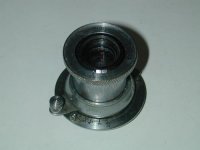Rogerzilla,
Thank You for the input. So I think I will try velvia on my 9cm and 5cm uncoated elmars. I have a super clean 35mm summicron v1 that I used with velvia 50, and was VERY happy with the result. But I was under very dense vegetation surroundings (sub-tropical like conditions of some western Japan "forest" in summer), and had no issues with contrast. It performed nicely under the sky of summer southern France (early morning or evening). However, I tried the same with my coated summitar, and it was a so so impression. I regret somehow the times of agfa rsx (very different, but quite high contrast still) I managed to use in most situation.
Actually, but this may very well be my lack of experience with leica glasses, I find that velvia suits best my slr's (FA; FM3a) Nikon optics.
Bingley,
You are right; I was not able to locate a single wide angle shot in his gallery. Which made me think of southern France. I am a native of rural south-west France and, actually, in small villages, very small towns, except if you shoot close perspective memorial monuments (WWI), or churches, I feel there is no need for a wide angle lens. Streets may be narrow, but they are also short or not very straight. Houses are not so big in height. And you can move at will: if you are polite, nobody will tell you not to stand on his grass or small courtyard. A 50mm (a 45mm is nice) and a 90mm are useful, and 28/35 are just options, on my opinion.
What is nice, in the south, for black and white pictures (shows up very well in Marco's work), is the texture of materials used in construction: anything is textured, somehow. The pink/orange bricks, hand cut stones, white limed/crusted walls, handmade stone pavements etc. etc. The scene gives in itself small 3D "elements" that participate nicely in picture taking. The light puts this in relief, and probably helps the "old glasses".
The same would apply to many places around the Mediterranean sea, of course. Japanese summer are dull in light, but I find that ancient wooden constructions, deeply marked tiles and earthen walls act in the same way.
In Marco pictures, his Paris serie is of great interest to me, as he is still sticking with a 50mm. But in Paris, scale of things is getting VERY different from small places of the south. Very instructive.


